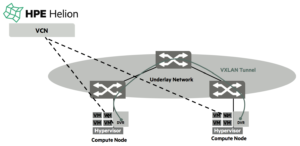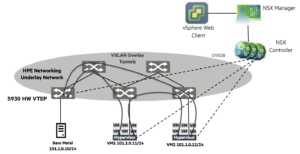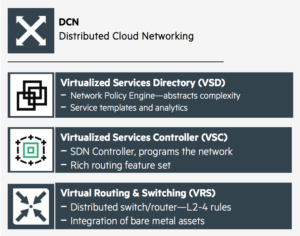Services Solutions

Hi everyone! In today's post we are going to talk about services and how do we enable our datacenter to handle all the computing requirements of those services while optimizing the bare-metal infrastructure. In order to achieve this goal we will be using virtualization, NFV & SDN techniques altogether with HPs specific orchestrating technologies so we are able to distribute the load and automatically respond to the requirements of the services running at every moment while optimizing the use of the physical equipments. HP proposes three different solutions enabled by different technologies which can be seen in the following picture.  HPE Helion OpenStack — Virtual Cloud Networking (VCN) HPE VCN is the enhanced Neutron networking component included as part of HPE Helion OpenStack. In the HPE Helion OpenStack solution, virtual overlay VXLAN networks are created via the HPE Helion OpenStack Horizon dashboard. VCN uses the Distributed Virtual Router (DVR) to dynamically set up and tear down VXLAN tunnels between compute nodes. Allowing to rapidly adapt the network and computing resources to the requirements of the moment with an open source, and non-complicated setup.
HPE Helion OpenStack — Virtual Cloud Networking (VCN) HPE VCN is the enhanced Neutron networking component included as part of HPE Helion OpenStack. In the HPE Helion OpenStack solution, virtual overlay VXLAN networks are created via the HPE Helion OpenStack Horizon dashboard. VCN uses the Distributed Virtual Router (DVR) to dynamically set up and tear down VXLAN tunnels between compute nodes. Allowing to rapidly adapt the network and computing resources to the requirements of the moment with an open source, and non-complicated setup.  VMware NSXv integration With the HPE VMware NSXv integration, HPE hardware VTEPs are able to integrate with VMware NSXv in order to bridge VMs on virtual networks to physical bare metal servers/physical firewalls/WAN routers as shown in the picture below. Virtual networks are created on the vSphere web client. This info is sent to the NSX manager and controller, which uses OVSDB to dynamically set up and tear down VXLAN tunnels between HPE hardware VTEPs and ESXi hypervisors. Since the NSXv controller knows about all the MAC addresses in the virtual networks, it shares these remote MAC addresses to VTEPs requiring this info via OVSDB. This architecture allows to integrate the native orchestration and NFV & SDN related capabilities of the HPE's hardware with Vmware's virtualization solutions.
VMware NSXv integration With the HPE VMware NSXv integration, HPE hardware VTEPs are able to integrate with VMware NSXv in order to bridge VMs on virtual networks to physical bare metal servers/physical firewalls/WAN routers as shown in the picture below. Virtual networks are created on the vSphere web client. This info is sent to the NSX manager and controller, which uses OVSDB to dynamically set up and tear down VXLAN tunnels between HPE hardware VTEPs and ESXi hypervisors. Since the NSXv controller knows about all the MAC addresses in the virtual networks, it shares these remote MAC addresses to VTEPs requiring this info via OVSDB. This architecture allows to integrate the native orchestration and NFV & SDN related capabilities of the HPE's hardware with Vmware's virtualization solutions.  HPE Distributed Cloud Networking HPE DCN provides large scale network virtualization, including federation, across multiple data centers. Virtual networks can be configured and consumed through HPE Helion OpenStack or HPE Matrix Operating Environment (MOE) or Cloud Service Automation (CSA). This acts as a broker for cloud services providing information which is also sent to HPE Virtualized Services Directory (VSD), which in turn provides a centralized orchestration and policy management framework. These policies are passed to HPE Virtualized Services Controller (VSC) for dynamic deployment seamlessly within and across data centers. To dynamically create VXLAN tunnels, the HPE VSC uses OVSDB to HPE hardware VTEPs and OpenFlow to software VTEPs with HPE Virtual Routing and Switching (VRS) agents residing in the hypervisors. The solution supports OpenSource KVM, VMware ESXi, Xen and Hyper-V. This infrastructure is the giant of the three proposed. With its three layers it completely abstracts the services running on the infrastructure and automatically manages them between all available resources including even those in different data centers.
HPE Distributed Cloud Networking HPE DCN provides large scale network virtualization, including federation, across multiple data centers. Virtual networks can be configured and consumed through HPE Helion OpenStack or HPE Matrix Operating Environment (MOE) or Cloud Service Automation (CSA). This acts as a broker for cloud services providing information which is also sent to HPE Virtualized Services Directory (VSD), which in turn provides a centralized orchestration and policy management framework. These policies are passed to HPE Virtualized Services Controller (VSC) for dynamic deployment seamlessly within and across data centers. To dynamically create VXLAN tunnels, the HPE VSC uses OVSDB to HPE hardware VTEPs and OpenFlow to software VTEPs with HPE Virtual Routing and Switching (VRS) agents residing in the hypervisors. The solution supports OpenSource KVM, VMware ESXi, Xen and Hyper-V. This infrastructure is the giant of the three proposed. With its three layers it completely abstracts the services running on the infrastructure and automatically manages them between all available resources including even those in different data centers.  Since we are working in the baking environment which has a lot of performance requirements and with several data centers, we are going with the third proposed solution, HPE Distributed Cloud Networking. Through its use we can first of all integrate all the bare metal assets and completely interconnect them, including those geographically distant, hence compacting all the computing power and getting a best performance of those. Then through the VSCs automated management of the network and services in a lower level is done therefore interconnecting the bare metal with the abstracted services which are managed centrally for all the system on the VSD. This solution allows to consolidate the computational resources and reduce the amount of physical equipment required to achieve the goals the infrastructure is meant to satisfy. Also through the use of the VSD and VSC and HPs specific protocols and technologies, the services can be moved between datacenters although all the geographic locations can be thought as one big flat infrastructure.
Since we are working in the baking environment which has a lot of performance requirements and with several data centers, we are going with the third proposed solution, HPE Distributed Cloud Networking. Through its use we can first of all integrate all the bare metal assets and completely interconnect them, including those geographically distant, hence compacting all the computing power and getting a best performance of those. Then through the VSCs automated management of the network and services in a lower level is done therefore interconnecting the bare metal with the abstracted services which are managed centrally for all the system on the VSD. This solution allows to consolidate the computational resources and reduce the amount of physical equipment required to achieve the goals the infrastructure is meant to satisfy. Also through the use of the VSD and VSC and HPs specific protocols and technologies, the services can be moved between datacenters although all the geographic locations can be thought as one big flat infrastructure.
Add new comment